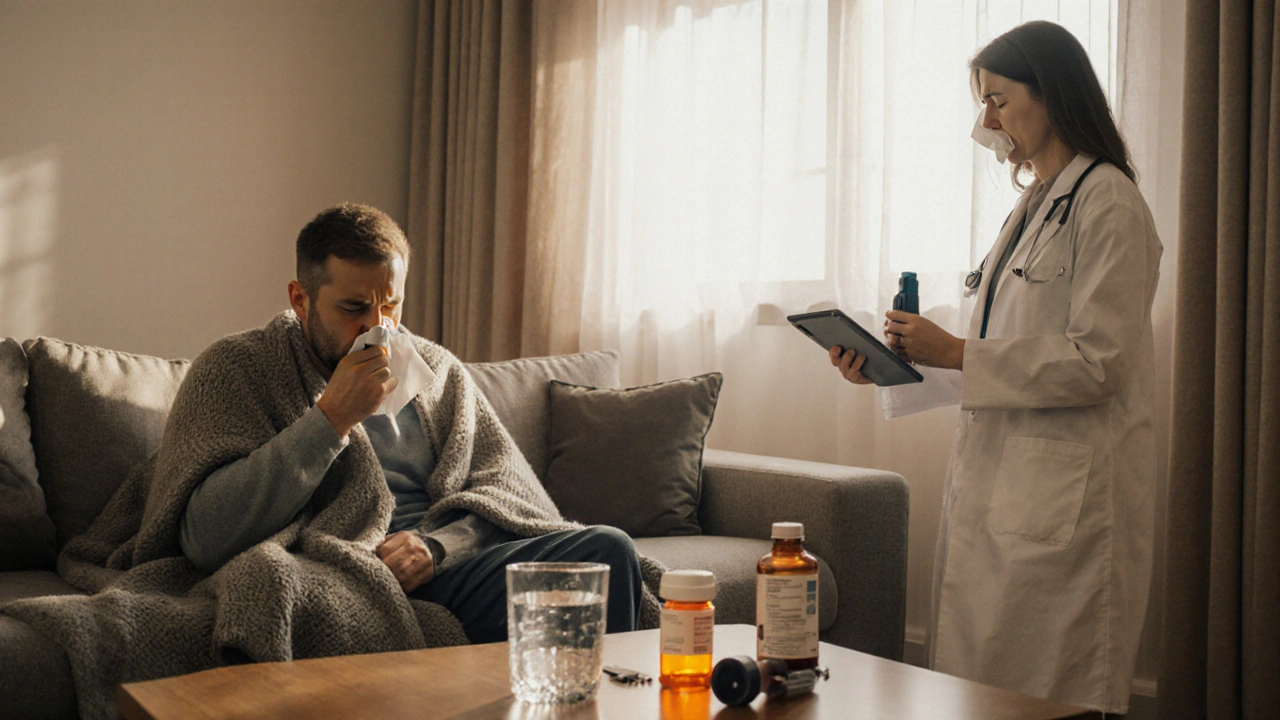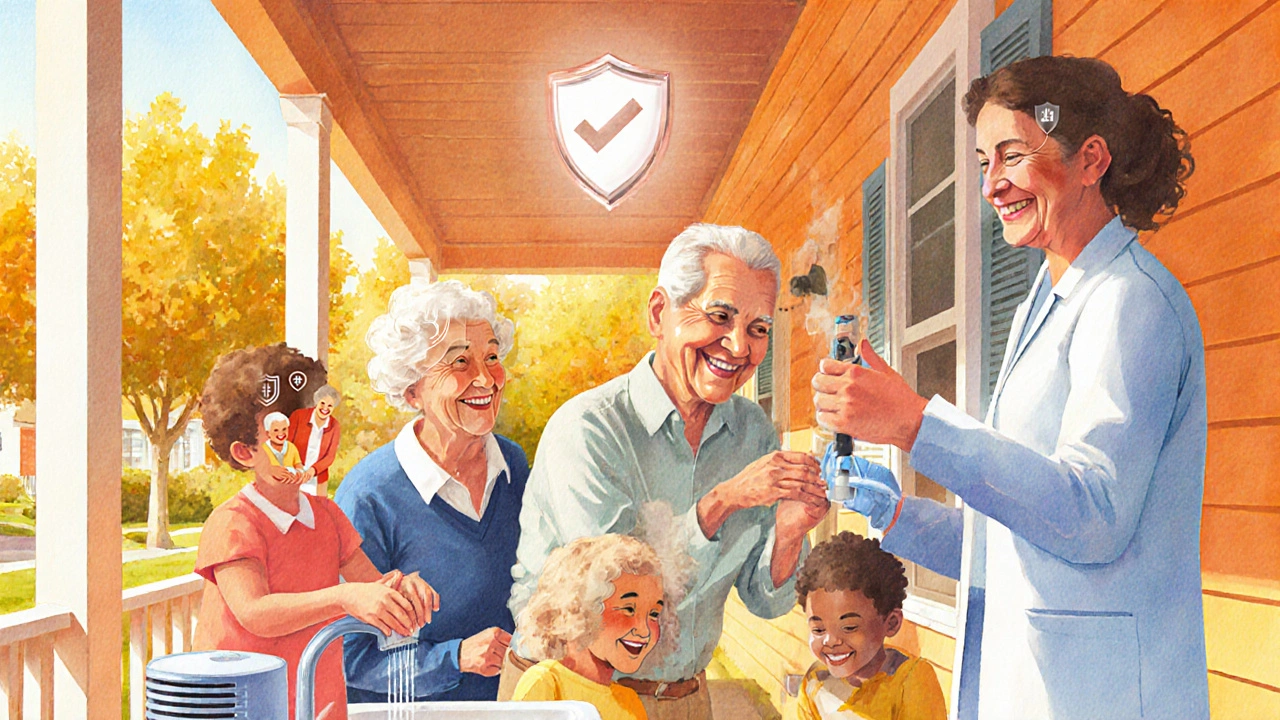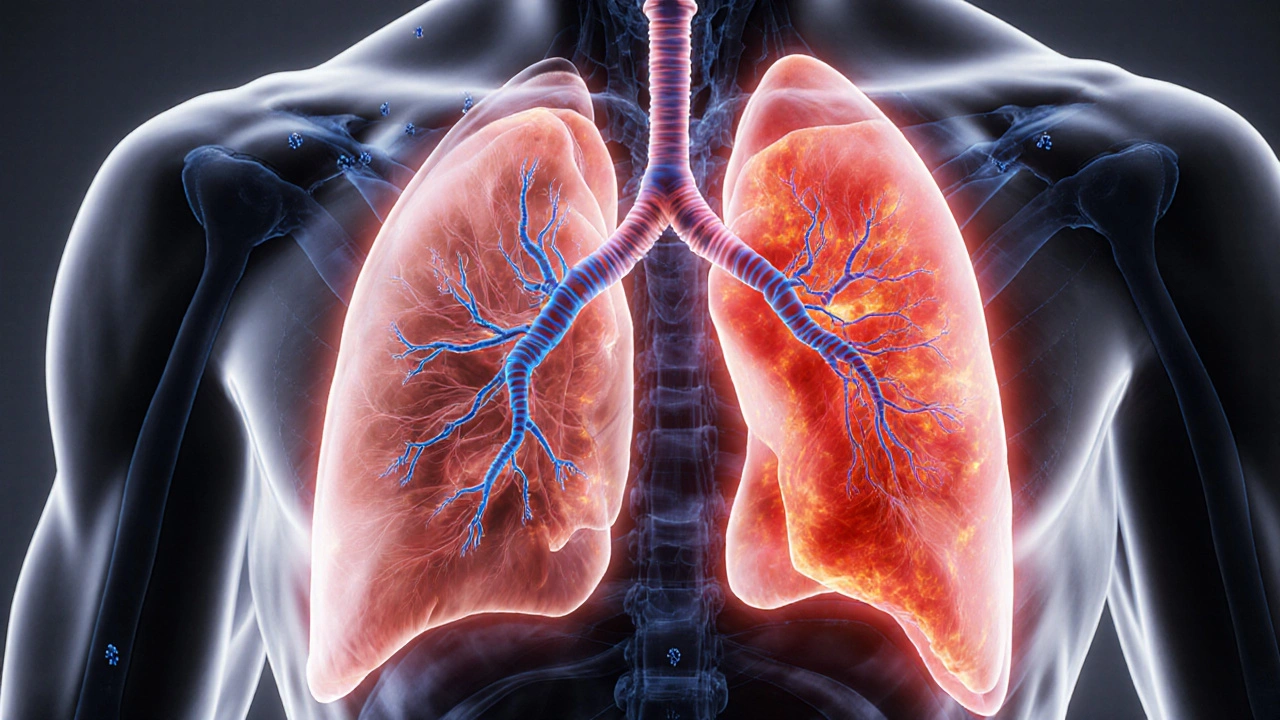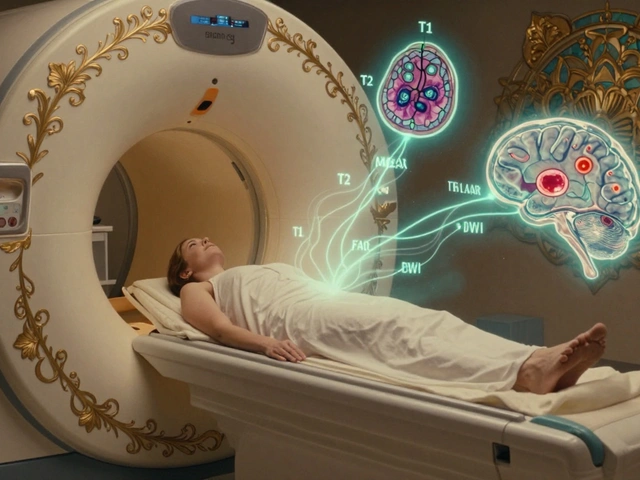Quick Takeaways
- • pneumonia inflames the alveoli tiny air sacs where oxygen exchange occurs, cutting oxygen flow.
- • Bacterial and viral forms hit the lungspair of organs that power breathing differently, so treatment varies.
- • Short‑term symptoms include fever, cough, and breathlessness; long‑term damage can leave scar tissue that limits lung capacity.
- • Early antibiotics for bacterial pneumonia and supportive care for viral cases speed recovery.
- • Vaccines, hand‑washing, and quitting smoking are the best defenses.
What Is Pneumonia?
Pneumonia is a lung infection that triggers inflammation of the air sacs (alveoli), often filling them with fluid or pus. When the alveoli fill up, they can’t exchange oxygen and carbon dioxide efficiently, which is why you feel short of breath. The condition can be sparked by bacteria, viruses, fungi, or even inhaled chemicals, but the two most common culprits are bacterial and viral agents.
The infection doesn’t stay confined to a single cell; it spreads through the delicate tissue of the respiratory systemnetwork of organs that moves air in and out of the body, often compromising the whole lung. Understanding the cascade of events helps you see why early treatment matters.
How Pneumonia Messes With Your Respiratory System
First, let’s zoom in on the lungspair of spongy organs tucked behind the ribcage that oxygenate blood. Air travels down the trachea, splits into bronchi, then branches into bronchioles ending in the alveoli. In a healthy lung, each alveolus is lined with a thin membrane that lets oxygen slip into the bloodstream while carbon dioxide slips out.
When pneumonia strikes, the inflammationbody’s immune response that causes swelling, redness, and fluid buildup floods the alveoli with fluid, immune cells, and sometimes pus. This fluid acts like a barrier, turning the once‑clear air‑blood interface into a soggy mess. The result? Your body can’t take in enough oxygen, and carbon dioxide lingers, leading to the classic feeling of “air hunger.”
The immune systemdefensive network of cells and proteins that fights infection works overtime, releasing cytokines that cause fever and increase heart rate. While this response is essential for clearing the invader, an over‑zealous reaction can damage the delicate lung tissue further.
Short‑Term Effects: Symptoms and Immediate Damage
Within days of infection, most people notice a constellation of symptoms: high fever, chills, a hacking cough that may spit up frothy sputum, and sharp chest pain that worsens with deep breaths. The cough isn’t just a nuisance-it’s the body’s way of trying to clear fluid‑laden alveoli.
Breathlessness often spikes at night because lying down pushes fluid toward the back of the lungs, a phenomenon called orthopnea. If oxygen levels dip too low, you might see a bluish tint around the lips (cyanosis) or feel dizzy. These signs signal that the respiratory system’s core function-oxygen exchange-is compromised.
For people with pre‑existing conditions like asthma or COPD, pneumonia can trigger an acute exacerbation, making the short‑term impact even more severe. In such cases, hospitalization is common, and doctors may introduce supplemental oxygen or even mechanical ventilation to hold the oxygen bar up while the lungs heal.

Long‑Term Consequences: Scarring and Reduced Capacity
Most individuals bounce back fully if they receive prompt treatment, but a subset experiences lingering effects. Persistent inflammation can lead to Fibrosis-scar tissue forming inside the alveoli. This scar tissue is stiff and doesn’t participate in gas exchange, effectively reducing the total surface area available for oxygen uptake.
Reduced lung capacity manifests as decreased stamina, a lingering cough, or occasional breathlessness during exertion. Studies from the British Lung Foundation show that around 10‑15% of severe pneumonia survivors report measurable drops in forced vital capacity (FVC) six months after discharge.
Older adults and smokers are especially vulnerable because their baseline lung reserve is already limited. In extreme cases, chronic post‑pneumonia fibrosis can evolve into a form of restrictive lung disease, requiring long‑term pulmonary rehabilitation.
Bacterial vs. Viral Pneumonia - What’s the Difference?
| Aspect | Bacterial Pneumonia | Viral Pneumonia |
|---|---|---|
| Common Pathogens | Streptococcus pneumoniae, Haemophilus influenzae | Influenza, Respiratory syncytial virus (RSV) |
| Onset Speed | Sudden, high fever within hours | Gradual, may start with flu‑like symptoms |
| Sputum Color | Thick, purulent (yellow/green) | Clear or watery |
| Treatment | Antibioticsdrugs that kill or inhibit bacteria are first‑line | Supportive care; antiviral meds only for specific viruses |
| Complication Rate | Higher risk of empyema (pus in chest cavity) | Often milder, but can lead to secondary bacterial infection |
Understanding these nuances helps doctors prescribe the right therapy quickly. Mistaking a viral case for bacterial can expose you to unnecessary antibiotics, which fuel resistance.
Treatment and Recovery: What Helps Your Lungs Heal
For bacterial pneumonia, the cornerstone is antibioticsmedicines that target bacterial cell walls or protein synthesis. A typical course lasts 5‑7 days, but doctors may extend it if you’re over 65 or have chronic illnesses.
Viral cases rely on rest, hydration, and, if available, antivirals like oseltamivir for flu. Supplemental oxygen, whether via nasal cannula or face mask, keeps blood‑oxygen levels safe while the alveoli clear the fluid.
Physical therapy plays a hidden but vital role. Gentle breathing exercises-like diaphragmatic breathing and incentive spirometry-re‑expand collapsed alveoli and speed fluid reabsorption. Most patients notice a marked improvement after the first 48‑72 hours of combined medical and supportive care.
Prevention Tips: Keeping Pneumonia at Bay
The best offense is a solid defense. Vaccines are the most effective shield: the pneumococcal vaccine (PCV13 or PPSV23) covers the most common bacterial strains, while the annual flu shot cuts down viral pneumonia risk.
Simple hygiene habits-regular hand‑washing, avoiding close contact with sick people, and covering your mouth when coughing-reduce exposure to pathogens. For smokers, quitting dramatically lowers the odds of both acquiring and suffering severe pneumonia.
Finally, maintain a balanced diet rich in vitamins A, C, and D, and stay physically active. A robust immune system can fend off the initial infection before it spreads to the lungs.

Frequently Asked Questions
Can pneumonia cause permanent lung damage?
In most cases the lungs recover fully, but severe or untreated pneumonia can leave scar tissue (fibrosis) that permanently reduces lung capacity. Older adults and smokers are most at risk for lasting effects.
How quickly do antibiotics work for bacterial pneumonia?
Patients often feel a drop in fever and improvement in breathing within 48‑72hours. Full radiographic clearance can take weeks, so finishing the prescribed course is essential.
Is it safe to exercise during recovery?
Gentle, doctor‑approved breathing exercises are encouraged early on. Strenuous cardio should wait until your doctor confirms oxygen levels are stable and you’re no longer coughing up sputum.
Do children need a different treatment plan?
Kids often receive the same antibiotics but dosed by weight. Hospital observation is more common for infants because they can dehydrate quickly.
Can a mild case of pneumonia be treated at home?
If you’re otherwise healthy, have no severe breathing difficulty, and can take oral antibiotics, a doctor may approve home care with close monitoring of temperature and oxygen levels.







Real Strategy PR
September 28, 2025 AT 00:15Pneumonia isn’t just a disease, it’s a test of personal responsibility. If you skip your vaccines, you’re not only endangering yourself but also burdening the healthcare system. Stay informed, stay healthy.
Doug Clayton
October 5, 2025 AT 19:11Thanks for the thorough breakdown. I especially liked the part about breathing exercises. They’re simple but can make a big difference in recovery. Keep the info coming.
Michelle Zhao
October 13, 2025 AT 14:07Esteemed colleagues, the gravitas of pulmonary afflictions such as pneumonia cannot be overstated. One must regard the alveolar inundation as a tragic ballet wherein each gasp is a lament. The ensuing hypoxia bespeaks a lamentable frailty of mortal flesh. Yet, through swift antimicrobial intervention, we may yet rewrite this somber narrative. Thus, let us not disregard the perils of complacency.
Eric Parsons
October 21, 2025 AT 09:03From a physiological standpoint, the alveolar fluid accumulation you read about acts like a sponge, soaking up the oxygen that would normally diffuse into the bloodstream. This inefficiency forces the heart to pump faster, which you’ll notice as an elevated pulse. In practice, supplemental oxygen reduces that workload and gives the lungs a chance to clear the exudate. Pairing this with incentive spirometry can re‑expand collapsed sacs faster than rest alone. The combination is often what shortens hospital stays.
Mary Magdalen
October 29, 2025 AT 02:59What’s really missing from this Western‑centric narrative is a shout‑out to home‑grown remedies that have kept our troops fighting fit for centuries. The so‑called “incentive spirometer” is a glorified balloon – why not use simple breath‑holding drills honed on the frontlines? Our ancestors didn’t wait for fancy devices; they trained their lungs with gritty, real‑world exercises. Embrace that spirit instead of bowing to imported tech.
Dhakad rahul
November 5, 2025 AT 21:55Ah, the lament of the modern patient! 😢 The halls of our hospitals echo with the sighs of those who dared trust foreign protocols over indigenous wisdom. Let us rise, dear compatriots, and reclaim the sanctity of our own healing arts! 🌟
William Dizon
November 13, 2025 AT 16:51Great summary! For anyone recovering at home, remember to stay hydrated and set a reminder to do gentle diaphragm stretches every few hours. Small steps add up, and you’ll notice your breathing improve day by day.
Jenae Bauer
November 21, 2025 AT 11:47Some say pneumonia is just a bug, but have you considered the hidden agenda behind the “vaccines” that the pharma giants push? They want us dependent, and the very *so‑called* antibiotics are a distraction from the real cure that’s being suppressed. Think about it.
vijay sainath
November 29, 2025 AT 06:43Look, you’re over‑thinking it. The virus is a virus, the antibiotics are proven. No grand conspiracy, just science.
Daisy canales
December 7, 2025 AT 01:39Sure, because breathing exercises are totally a weekend hobby.
keyul prajapati
December 7, 2025 AT 01:39When examining the cascade of events that occur during a pneumonic infection, it becomes evident that each anatomical structure plays a distinct yet interconnected role. The trachea serves as the primary conduit, delivering inhaled air to the bifurcating bronchi, which in turn subdivide into countless bronchioles, each terminating in an alveolus. Under healthy conditions, these alveoli are lined with a delicate surfactant layer that minimizes surface tension, allowing effortless gas exchange. Once the pathogenic agents infiltrate, the immune response initiates inflammation, recruiting neutrophils and macrophages to the site. This cellular influx, while essential for pathogen clearance, also releases cytokines that increase vascular permeability. Consequently, plasma leaks into the alveolar space, creating an edematous environment that hampers oxygen diffusion. The resulting hypoxemia stimulates the respiratory centers in the brainstem, leading to tachypnea as the body attempts to compensate. Simultaneously, carbon dioxide retention may develop, further challenging the acid‑base balance. Clinically, patients present with a characteristic productive cough, often described as “frothy” due to the presence of fluid. Fever and chills accompany the systemic inflammatory response, reflecting the body’s attempt to create an unfavorable temperature for the pathogen. Radiographically, infiltrates appear as patchy opacities, predominantly in the lower lobes, correlating with gravity‑dependent fluid accumulation. Therapeutically, the administration of appropriate antibiotics targets bacterial replication mechanisms, while supportive care-such as supplemental oxygen-maintains adequate tissue perfusion. In viral cases, the focus shifts toward immune modulation and antiviral agents where indicated. Rehabilitation strategies, including incentive spirometry and chest physiotherapy, facilitate the clearance of residual secretions and promote alveolar re‑expansion. Finally, preventive measures, notably immunization and smoking cessation, constitute the most effective means of reducing incidence and severity. The integration of these concepts underscores the complexity of pneumonia management and highlights the importance of a multidisciplinary approach.
Alice L
December 14, 2025 AT 20:35Esteemed readers, it is incumbent upon us to recognize the global diversity of respiratory health practices. While Western medicine emphasizes pharmacologic interventions, many cultures have long upheld herbal infusions and breath‑control techniques as prophylaxis against pulmonary ailments. Such traditions merit scholarly attention and respectful integration into contemporary treatment paradigms.
Seth Angel Chi
December 22, 2025 AT 15:30Most lay summaries overlook the nuanced pathophysiology and settle for platitudes the mass media feeds the public it is a disservice to encourage deeper study